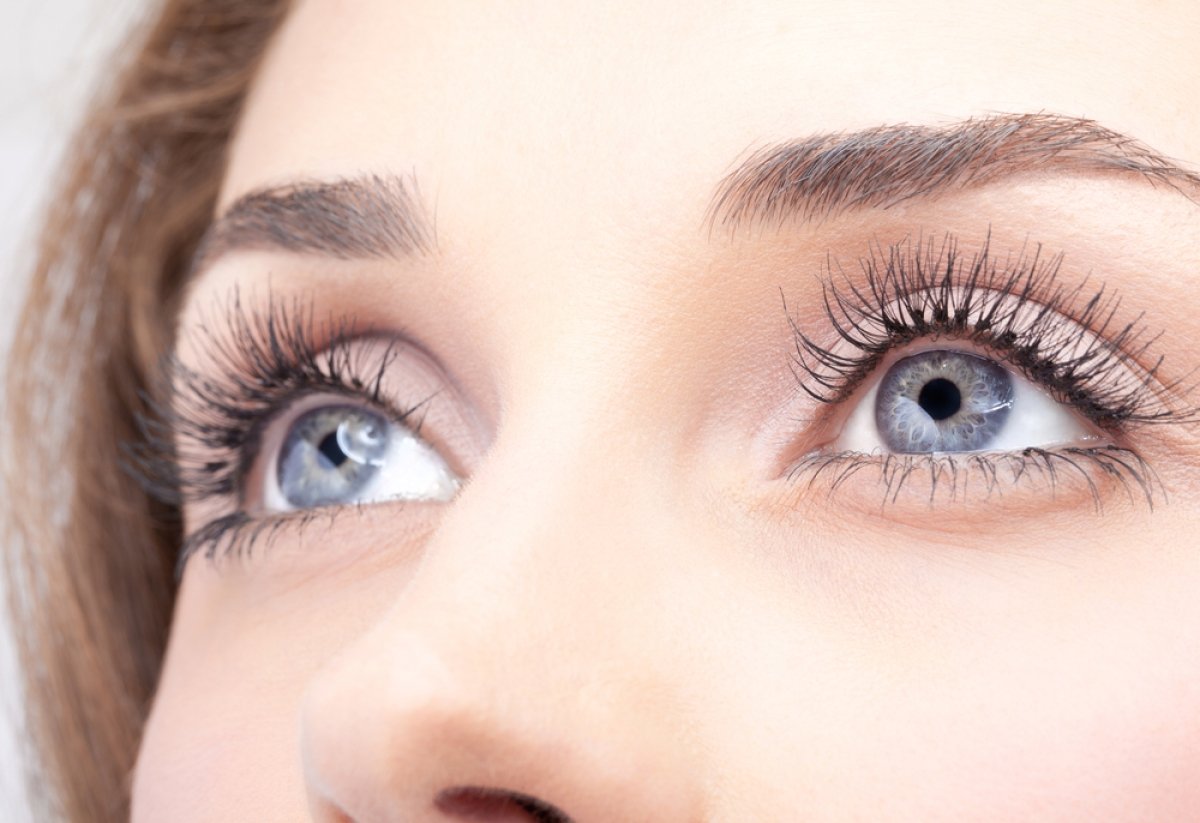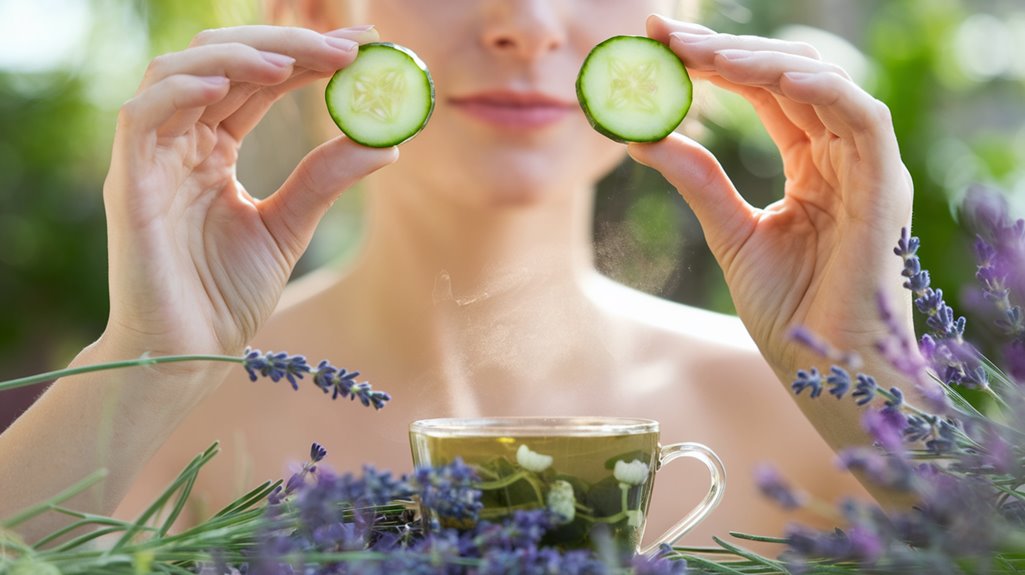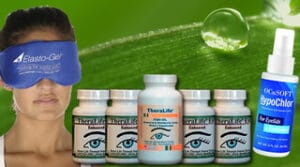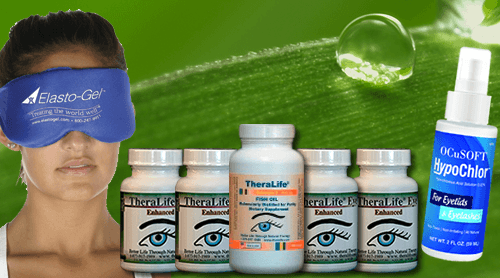To naturally soothe watery eyes, consider exploring the benefits of TheraLife’s products, designed to support comprehensive eye health. TheraLife offers supplements that address various eye conditions, helping to stabilize tear production and reduce inflammation. Their formulations can be particularly beneficial for those suffering from chronic dry eyes, blepharitis, or uveitis, providing relief through natural ingredients that enhance overall eye wellness.
In addition to using TheraLife’s products, wearing sunglasses or protective eyewear can shield your eyes from wind and allergens, while maintaining hydration by drinking 8-10 glasses of water daily is essential. Incorporating omega-3s and beta-carotene-rich foods into your diet also supports eye health. TheraLife’s supplements align with these lifestyle changes by promoting eye comfort and mitigating symptoms associated with environmental and dietary factors.
TheraLife’s focus on treating conditions like blepharitis, dry eye syndrome, and uveitis with natural solutions positions them as a valuable resource for those seeking long-term eye health improvements. Discover how integrating TheraLife’s products into your routine can provide significant and lasting relief for watery eyes.
Powerful Oral Treatment For Watery Eyes Relief
Add To Cart
Key Takeaways
- Use warm compresses to enhance tear film stability and soothe inflammation naturally.
- Apply chamomile or eyebright herbal remedies to benefit from their anti-inflammatory properties.
- Maintain eyelid hygiene with gentle scrubs to prevent conditions causing watery eyes.
- Limit outdoor exposure during high pollen counts to reduce allergen-induced eye irritation.
- Incorporate omega-3-rich foods to support retinal health and reduce watery eye symptoms.
Protective Eyewear Essentials For Watery Eyes
When it comes to protecting your eyes, understanding the essentials of protective eyewear is essential.
You need to choose the right protective eyewear types depending on your activities. For sports like basketball or soccer, sports goggles with polycarbonate lenses offer superior impact resistance.
If you’re swimming, swim goggles shield your eyes from pool chemicals.
Don’t forget sunglasses for outdoor activities; they provide important UV protection, blocking 99% to 100% of UVA and UVB rays. This is necessary since UV radiation can damage your eyes even on cloudy days, leading to cataracts or retinal degeneration. Reflective surfaces like water and snow can significantly increase your exposure to UV rays, making effective eyewear even more crucial.
For high-speed activities, consider motorcycle glasses with foam rubber construction to block wind and reduce tears.
Always look for eyewear with UV400 protection for the best defense against harmful rays.
Your eyes deserve the best care, so choose wisely.
Hydration and Humidifiers For Watery Eyes
As you endeavor to keep your eyes comfortable and healthy, focusing on hydration and humidifiers can make a significant difference.
Drinking 8-10 glasses of water daily supports tear production, an essential hydration benefit that prevents dry eyes by maintaining the tear film. This guarantees a balanced salt concentration, reducing irritation. Incorporate water-rich foods like cucumbers to boost hydration naturally. Dehydration leads to reduced tear production, affecting eye moisture significantly. Chronic dry eyes, if not addressed, can lead to complications like blepharitis and meibomian gland dysfunction.
Humidifiers are invaluable in dry environments, adding moisture to the air and alleviating discomfort. Set humidifier settings to maintain ideal humidity levels, especially in winter or air-conditioned spaces.
By combining these strategies, you create a supportive environment for your eyes, helping them stay moist and comfortable.
Screen Time Management For Watery Eyes
Although the digital world offers many conveniences, managing screen time is essential for maintaining eye health. Your screen habits greatly impact your eyes, so consider implementing the 20-20-20 rule. Every 20 minutes, take a digital break by looking at something 20 feet away for 20 seconds. Adjust your screen’s brightness and contrast, and use a matte filter to reduce strain. Position your screen so that your eyes gaze slightly downward. Prolonged gazing at screens can lead to dry eyes and discomfort, highlighting the importance of effective screen time management. Maintaining a balanced tear film is crucial for preventing dry eye conditions. Here’s a quick guide:
| Tips for Eye Health | Why It Helps | Action Steps |
|---|---|---|
| 20-20-20 Rule | Reduces eye strain | Look away every 20 minutes |
| Screen Brightness | Matches surrounding light | Adjust to room lighting |
| Screen Position | Comfort for eyes | Keep screen slightly below eye level |
| Regular Digital Breaks | Prevents dryness | Take frequent short breaks |
Incorporate these strategies to alleviate watery eyes and maintain your overall eye health.
Herbal and Warm Compresses
If you’re seeking natural remedies to soothe your watery eyes, consider incorporating herbal and warm compresses into your routine.
Herbal remedies like chamomile and eyebright offer anti-inflammatory benefits, providing comfort for various eye ailments. Black tea bags, rich in antioxidants, can combat puffiness and irritation. For a calming effect, lavender tea bags are soothing for dry, irritated eyes. Regular use of warm compresses can lead to significant improvements in tear film stability and reduction of inflammation.
To prepare, boil water, steep your chosen herbal tea bag, let it cool, and place it over closed eyes for about 5 minutes. Consult a doctor if symptoms persist to ensure proper diagnosis and treatment.
Warm compress techniques involve applying a clean, warm cloth to your eyelids for 5-10 minutes, several times a day. This method reduces inflammation, enhances eyelid hygiene, and stimulates oil production.
Remember to verify the compress isn’t too hot and keep everything hygienic.
Dietary Support for Eye Health For Watery Eyes
When it comes to supporting your eye health, your diet plays a crucial role in maintaining clear and comfortable vision. Embrace nutrient-rich foods like kale, spinach, and red peppers, which offer lutein, zeaxanthin, and vitamin C to shield your eyes from harmful light and potential cataracts. Carrots and sweet potatoes deliver beta-carotene, converting to vitamin A, essential for vision. Don’t overlook the omega-3 benefits found in salmon, sardines, and walnuts. These fatty acids support retinal health and combat dry eyes with their anti-inflammatory properties. Omega-3 fatty acids, particularly DHA, are crucial for retinal health and can help reduce inflammation in the eyes. Studies show mixed results regarding their effectiveness for relieving dry eye symptoms, with some research indicating potential benefits while others find limited evidence. Aim to include fatty fish at least twice a week, and diversify your diet with a variety of fruits and vegetables. Your eyes deserve the best nutrition for long-term wellness.
Saline and Honey Solutions For Watery Eyes
For those seeking natural remedies for watery eyes, both saline and honey solutions offer promising benefits.
Saline benefits include effectively flushing out irritants, allergens, and debris, providing immediate relief while maintaining eye hygiene. Prepare a sterile saline solution by mixing 1 teaspoon of non-iodized salt with 1 cup of distilled water. Confirm it’s stored in an airtight container at room temperature, and use clean hands to avoid contamination. It’s important to note that while saline is safe for ocular use if sterile, it is not recommended as a long-term treatment for dry eyes. The economic burden of dry eye disease, despite its simple home remedies, underscores the importance of considering professional medical advice for ongoing symptoms.
Honey properties also contribute to soothing watery eyes. Honey is known for its anti-inflammatory and antibacterial qualities, which can help alleviate irritation. Use a diluted honey solution by mixing equal parts of honey and distilled water, applying carefully to the affected area.
Always consult with a healthcare professional before trying new remedies.
Allergy and Irritant Control For Watery Eyes
After exploring natural solutions like saline and honey, managing allergies and irritants becomes a key step in soothing watery eyes.
Start with allergen tracking—keep a log to identify triggers like pollen, dust mites, or pet dander. Regular cleaning can greatly reduce these indoor allergens. Wearing protective eyewear can serve as a barrier against wind, dust, and pollen, significantly reducing eye discomfort.
During peak pollen seasons, keep windows closed and rely on air conditioning. Air purifiers with HEPA filters are effective for irritant reduction, improving your indoor air quality. Limiting outdoor activities during these times can also help reduce exposure to allergens.
Outdoors, wear sunglasses to shield your eyes from pollen and dust. Avoid outdoor activities during high pollen counts or strong winds.
Indoors, vacuum regularly and consider replacing carpets with hard flooring. These practical steps help minimize exposure to allergens and relieve your watery eyes naturally.
Regular Eyelid Hygiene For Watery Eyes
Maintaining regular eyelid hygiene is essential for preventing various eye conditions and guaranteeing your eyes remain comfortable and healthy.
By practicing effective eyelid cleaning techniques, you can ward off issues like blepharitis, styes, and meibomitis. Start with a gentle eyelid scrub using a non-irritating shampoo or a prepared solution, which removes debris and allergens. This not only reduces irritation but also stimulates healthy tear production. Consistent lid hygiene acts as a vital preventative measure against several eye conditions, ensuring your eyes are less susceptible to infections and other problems. Regular eyelid hygiene is crucial because poor eyelid hygiene can exacerbate symptoms of blepharitis, leading to frequent flare-ups and discomfort.
Incorporating a warm compress for 3-5 minutes softens oil secretions, promoting gland function. Gently massage and clean the eyelid edges with a cotton bud or wipe.
The eyelid scrub benefits extend to reducing eye watering and improving overall eye health. Consistent practice, twice a day, guarantees long-term relief and healthier eyes.
Eye Exams and Medical Care For Watery Eyes
Although watery eyes can often be managed with simple remedies, regular eye exams and medical care are crucial to confirm there’s no underlying condition causing the discomfort. Understanding the eye exam importance is essential for a thorough watery eye evaluation. You should aim for consistent check-ups based on your age and risk factors. Eye exams help identify potential issues through assessments like the Schirmer test and physical examinations. In addition to diagnosing eye diseases such as glaucoma and macular degeneration, eye exams can reveal signs of serious health conditions like diabetes and high blood pressure. Environmental factors, such as dry air and prolonged screen time, can exacerbate symptoms and should be discussed with your eye care provider.
| Age Group | Low-Risk Frequency | At-Risk Frequency |
|---|---|---|
| 18-39 | Every 2 years | Annually |
| 40-54 | Every 2-4 years | Annually |
| 55-64 | Every 1-3 years | Annually |
| 65 and up | Every 1-2 years | Annually |
Don’t ignore persistent symptoms; timely medical care can prevent complications and maintain ideal eye health.
Frequently Asked Questions For Watery Eyes
How Can I Naturally Reduce Eye Inflammation Without Medication?
To naturally reduce eye inflammation, try cold compresses. They soothe irritation and decrease swelling.
Herbal infusions like green tea bags are effective due to their calming properties. Use them cooled over closed eyes.
Incorporate aloe vera or castor oil, known for their anti-inflammatory benefits, into your routine.
Make certain your environment is clean and humidified to prevent further irritation.
What Are the Best Natural Remedies for Soothing Eye Irritation?
To soothe eye irritation naturally, you can use herbal compresses like chamomile or eyebright, which have anti-inflammatory properties.
Simply cool tea bags and place them over your closed eyes for relief.
Cucumber slices also work wonders due to their anti-inflammatory effects.
Regular use of these natural remedies can help calm irritation and reduce redness.
Are There Specific Exercises to Help Alleviate Watery Eyes?
Imagine gently closing your eyes, feeling the warmth of your palms as you cover them. This simple eye exercise can help alleviate watery eyes.
Try blink techniques like rapid blinking for 20 seconds to reduce fatigue. Alternate focusing on nearby and distant objects to strengthen your eye muscles.
These exercises, grounded in evidence, can soothe your eyes naturally. Remember, your eyes deserve care and attention to maintain their health.
Can Yoga or Meditation Benefit Those With Watery Eyes?
You can benefit from yoga and meditation if you have watery eyes.
Yoga benefits include reducing eye strain and improving focus through eye yoga exercises.
Meditation techniques help alleviate stress-related eye issues by promoting relaxation and improving circulation.
Combining both practices can enhance relaxation, reduce eye strain, and support overall eye health.
These approaches are evidence-based and provide a natural, holistic way to soothe your watery eyes effectively.
How Does Stress Reduction Impact Eye Moisture Levels?
Reducing stress can greatly improve your eye moisture levels.
When you manage stress effectively through techniques like mindfulness and regular exercise, you lower cortisol levels, which helps maintain proper tear production.
Staying hydrated also supports this process, as adequate hydration levels are essential for a healthy tear film.
Conclusion For Watery Eyes
Taking care of your eyes is akin to nurturing a delicate garden, and TheraLife’s products offer the essential tools and resources to ensure your eyes remain healthy and comfortable. TheraLife provides a comprehensive approach to eye health by offering products that alleviate symptoms of conditions like blepharitis, dry eyes, and uveitis. Their solutions include herbal-based treatments and dietary supplements, designed to enhance eye comfort and reduce inflammation naturally.
For blepharitis, TheraLife’s products effectively manage symptoms through natural ingredients that help maintain eyelid hygiene and reduce crustiness. They also offer insights into the best and worst places for dry eye sufferers, providing lifestyle tips to minimize discomfort. Their specialized treatments for uveitis focus on soothing inflammation using nature-inspired methods.
TheraLife’s offerings also include guidance on handling eye-related complications from conditions such as Sjögren’s syndrome and rheumatoid arthritis. Their products are formulated to address issues like recurrent chalazion, eyelash mites, and rosacea-related dry eyes. They emphasize the importance of an anti-inflammatory diet and proper eye makeup choices to support overall eye health.
By integrating TheraLife’s products into your routine, you ensure your eyes are well-nurtured, akin to a thriving garden. Regular use alongside professional eye care guarantees clarity and comfort, allowing you to see the world with refreshed and healthy eyes.
References
- 1.
- 2.
- Nemet AY. The Etiology of Epiphora: A Multifactorial Issue. Semin Ophthalmol. 2016;31(3):275-9. [PubMed]
- 3.
- Shen GL, Ng JD, Ma XP. Etiology, diagnosis, management and outcomes of epiphora referrals to an oculoplastic practice. Int J Ophthalmol. 2016;9(12):1751-1755. [PMC free article] [PubMed]
- 4.
- Patel J, Levin A, Patel BC. StatPearls [Internet]. StatPearls Publishing; Treasure Island (FL): Aug 7, 2023. Epiphora. [PubMed]
- 5.
- Gurnani B, Kaur K. StatPearls [Internet]. StatPearls Publishing; Treasure Island (FL): Jun 11, 2023. Bacterial Keratitis. [PubMed]
- 6.
- Basu S. Seeing through tears: Understanding and managing dry eye disease. Indian J Ophthalmol. 2023 Apr;71(4):1065-1066. [PMC free article] [PubMed]
- 7.
- Icasiano E, Latkany R, Speaker M. Chronic epiphora secondary to ocular rosacea. Ophthalmic Plast Reconstr Surg. 2008 May-Jun;24(3):249. [PubMed]
- 8.
- 9.
- Tse DT, Erickson BP, Tse BC. The BLICK mnemonic for clinical-anatomical assessment of patients with epiphora. Ophthalmic Plast Reconstr Surg. 2014 Nov-Dec;30(6):450-8. [PubMed]
- 10.
- Webber NK, Setterfield JF, Lewis FM, Neill SM. Lacrimal canalicular duct scarring in patients with lichen planus. Arch Dermatol. 2012 Feb;148(2):224-7. [PubMed]
- 11.
- Portelinha J, Passarinho MP, Costa JM. Neuro-ophthalmological approach to facial nerve palsy. Saudi J Ophthalmol. 2015 Jan-Mar;29(1):39-47. [PMC free article] [PubMed]
- 12.
- Zhang Y, Zeng C, Chen N, Liu C. Lacrimal ductal cyst of the medial orbit: a case report. BMC Ophthalmol. 2020 Sep 24;20(1):380. [PMC free article] [PubMed]
- 13.
- Kim JS, Liss J. Masses of the Lacrimal Gland: Evaluation and Treatment. J Neurol Surg B Skull Base. 2021 Feb;82(1):100-106. [PMC free article] [PubMed]
- 14.
- Lievens CW, Rayborn E. Tribology and the Ocular Surface. Clin Ophthalmol. 2022;16:973-980. [PMC free article] [PubMed]
- 15.
- Al Saleh A, Vargas JM, Al Saleh AS. Supernumerary lacrimal puncta: Case series. Saudi J Ophthalmol. 2020 Oct-Dec;34(4):328-330. [PMC free article] [PubMed]
- 16.
- Kang S, Seo JW, Sa HS. Cancer-associated epiphora: a retrospective analysis of referrals to a tertiary oculoplastic practice. Br J Ophthalmol. 2017 Nov;101(11):1566-1569. [PubMed]
- 17.
- Esmaeli B, Hidaji L, Adinin RB, Faustina M, Coats C, Arbuckle R, Rivera E, Valero V, Tu SM, Ahmadi MA. Blockage of the lacrimal drainage apparatus as a side effect of docetaxel therapy. Cancer. 2003 Aug 01;98(3):504-7. [PubMed]
- 18.
- Chan W, Malhotra R, Kakizaki H, Leibovitch I, Selva D. Perspective: what does the term functional mean in the context of epiphora? Clin Exp Ophthalmol. 2012 Sep-Oct;40(7):749-54. [PubMed]
- 19.
- Perry JD. Dysfunctional epiphora: a critique of our current construct of “functional epiphora”. Am J Ophthalmol. 2012 Jul;154(1):3-5. [PubMed]
- 20.
- Maroto Rodríguez B, Stoica BTL, Toledano Fernández N, Genol Saavedra I. Treatment for functional epiphora with botulinum toxin-A versus lateral tarsal strip in a randomized trial. Arch Soc Esp Oftalmol (Engl Ed). 2022 Oct;97(10):549-557. [PubMed]
- 21.
- Ozturker C, Purevdorj B, Karabulut GO, Seif G, Fazil K, Khan YA, Kaynak P. A Comparison of Transcanalicular, Endonasal, and External Dacryocystorhinostomy in Functional Epiphora: A Minimum Two-Year Follow-Up Study. J Ophthalmol. 2022;2022:3996854. [PMC free article] [PubMed]
- 22.
- Lee MJ, Park J, Yang MK, Choi YJ, Kim N, Choung HK, Khwarg SI. Long-term results of maintenance of lacrimal silicone stent in patients with functional epiphora after external dacryocystorhinostomy. Eye (Lond). 2020 Apr;34(4):669-674. [PMC free article] [PubMed]
- 23.
- Shams PN, Chen PG, Wormald PJ, Sloan B, Wilcsek G, McNab A, Selva D. Management of functional epiphora in patients with an anatomically patent dacryocystorhinostomy. JAMA Ophthalmol. 2014 Sep;132(9):1127-32. [PubMed]
- 24.
- Vagge A, Ferro Desideri L, Nucci P, Serafino M, Giannaccare G, Lembo A, Traverso CE. Congenital Nasolacrimal Duct Obstruction (CNLDO): A Review. Diseases. 2018 Oct 22;6(4) [PMC free article] [PubMed]
- 25.
- Mainville N, Jordan DR. Etiology of tearing: a retrospective analysis of referrals to a tertiary care oculoplastics practice. Ophthalmic Plast Reconstr Surg. 2011 May-Jun;27(3):155-7. [PubMed]
- 26.
- Ulusoy MO, Kıvanç SA, Atakan M, Akova-Budak B. How Important Is the Etiology in the Treatment of Epiphora? J Ophthalmol. 2016;2016:1438376. [PMC free article] [PubMed]
- 27.
- Ishikawa S, Murayama K, Kato N. The proportion of ocular surface diseases in untreated patients with epiphora. Clin Ophthalmol. 2018;12:1769-1773. [PMC free article] [PubMed]
- 28.
- Qian L, Wei W. Identified risk factors for dry eye syndrome: A systematic review and meta-analysis. PLoS One. 2022;17(8):e0271267. [PMC free article] [PubMed]
- 29.
- Cher I. Fluids of the ocular surface: concepts, functions and physics. Clin Exp Ophthalmol. 2012 Aug;40(6):634-43. [PubMed]
- 30.
- Martin R, Emo Research Group Comparison of the Ocular Surface Disease Index and the Symptom Assessment in Dry Eye Questionnaires for Dry Eye Symptom Assessment. Life (Basel). 2023 Sep 21;13(9) [PMC free article] [PubMed]
- 31.
- Kinoshita S, Ukyo H, Masuda N, Osawa S. Comparison of the Postoperative Outcomes of Posterior Layer Advancement and Modified Iliff Suturing to Correct Involutional Lower Lid Entropion. J Craniofac Surg. 2021 May 01;32(3):1143-1146. [PubMed]
- 32.
- Milbratz-Moré GH, Pauli MP, Lohn CLB, Pereira FJ, Grumann AJ. Lower Eyelid Distraction Test: New Insights on the Reference Value. Ophthalmic Plast Reconstr Surg. 2019 Nov/Dec;35(6):574-577. [PubMed]
- 33.
- Chen C, Malhotra R, Muecke J, Davis G, Selva D. Aberrant facial nerve regeneration (AFR): an under-recognized cause of ptosis. Eye (Lond). 2004 Feb;18(2):159-62. [PubMed]
- 34.
- Zhang YH, Feng J, Yi CY, Deng XY, Zhou YJ, Tian L, Jie Y. Dynamic tear meniscus parameters in complete blinking: insights into dry eye assessment. Int J Ophthalmol. 2023;16(12):1911-1918. [PMC free article] [PubMed]
- 35.
- Abraham ZS, Bukanu F, Kahinga AA. A missed giant rhinolith retained for a decade in a paediatric patient at a zonal referral hospital in Central Tanzania: Case report and literature review. Int J Surg Case Rep. 2022 Oct;99:107622. [PMC free article] [PubMed]
- 36.
- Bron AJ, de Paiva CS, Chauhan SK, Bonini S, Gabison EE, Jain S, Knop E, Markoulli M, Ogawa Y, Perez V, Uchino Y, Yokoi N, Zoukhri D, Sullivan DA. TFOS DEWS II pathophysiology report. Ocul Surf. 2017 Jul;15(3):438-510. [PubMed]
- 37.
- Singh Bhinder G, Singh Bhinder H. Reflex epiphora in patients with dry eye symptoms: role of variable time Schirmer-1 test. Eur J Ophthalmol. 2005 Jul-Aug;15(4):429-33. [PubMed]
- 38.
- Li N, Deng XG, He MF. Comparison of the Schirmer I test with and without topical anesthesia for diagnosing dry eye. Int J Ophthalmol. 2012;5(4):478-81. [PMC free article] [PubMed]
- 39.
- Mou Y, Xiang H, Lin L, Yuan K, Wang X, Wu Y, Min J, Jin X. Reliability and efficacy of maximum fluorescein tear break-up time in diagnosing dry eye disease. Sci Rep. 2021 Jun 01;11(1):11517. [PMC free article] [PubMed]
- 40.
- Sall K, Foulks GN, Pucker AD, Ice KL, Zink RC, Magrath G. Validation of a Modified National Eye Institute Grading Scale for Corneal Fluorescein Staining. Clin Ophthalmol. 2023;17:757-767. [PMC free article] [PubMed]
- 41.
- Bunya VY, Chen M, Zheng Y, Massaro-Giordano M, Gee J, Daniel E, O’Sullivan R, Smith E, Stone RA, Maguire MG. Development and Evaluation of Semiautomated Quantification of Lissamine Green Staining of the Bulbar Conjunctiva From Digital Images. JAMA Ophthalmol. 2017 Oct 01;135(10):1078-1085. [PMC free article] [PubMed]
- 42.
- Jamerson EC, Elhusseiny AM, ElSheikh RH, Eleiwa TK, El Sayed YM. Role of Matrix Metalloproteinase 9 in Ocular Surface Disorders. Eye Contact Lens. 2020 Mar;46 Suppl 2:S57-S63. [PubMed]
- 43.
- Papas EB. Diagnosing dry-eye: Which tests are most accurate? Cont Lens Anterior Eye. 2023 Oct;46(5):102048. [PubMed]
- 44.
- Wolffsohn JS, Arita R, Chalmers R, Djalilian A, Dogru M, Dumbleton K, Gupta PK, Karpecki P, Lazreg S, Pult H, Sullivan BD, Tomlinson A, Tong L, Villani E, Yoon KC, Jones L, Craig JP. TFOS DEWS II Diagnostic Methodology report. Ocul Surf. 2017 Jul;15(3):539-574. [PubMed]
- 45.
- Singh S, Donthineni PR, Srivastav S, Jacobi C, Basu S, Paulsen F. Lacrimal and meibomian gland evaluation in dry eye disease: A mini-review. Indian J Ophthalmol. 2023 Apr;71(4):1090-1098. [PMC free article] [PubMed]
- 46.
- Wong S, Srinivasan S, Murphy PJ, Jones L. Comparison of meibomian gland dropout using two infrared imaging devices. Cont Lens Anterior Eye. 2019 Jun;42(3):311-317. [PubMed]
- 47.
- Chidi-Egboka NC, Jalbert I, Chen J, Briggs NE, Golebiowski B. Blink Rate Measured In Situ Decreases While Reading From Printed Text or Digital Devices, Regardless of Task Duration, Difficulty, or Viewing Distance. Invest Ophthalmol Vis Sci. 2023 Feb 01;64(2):14. [PMC free article] [PubMed]
- 48.
- Pult H, Riede-Pult B. Comparison of subjective grading and objective assessment in meibography. Cont Lens Anterior Eye. 2013 Feb;36(1):22-7. [PubMed]
- 49.
- Kashkouli MB, Mirzajani H, Jamshidian-Tehrani M, Pakdel F, Nojomi M, Aghaei GH. Reliability of fluorescein dye disappearance test in assessment of adults with nasolacrimal duct obstruction. Ophthalmic Plast Reconstr Surg. 2013 May-Jun;29(3):167-9. [PubMed]
- 50.
- Bowyer JD, Holroyd C, Chandna A. The use of the fluorescein disappearance test in the management of childhood epiphora. Orbit. 2001 Sep;20(3):181-187. [PubMed]





